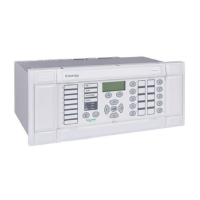Application Notes P54x/EN AP/La4
MiCOM P543, P544, P545 & P546
(AP) 6-69
AP
3.6.4 Intermicom
64
application example scheme description
The scheme in Figure 26 is assumed as a case study. The top half of the page shows the
mappin
g of the send and receive logic as already described. It can be seen that the first
InterMiCOM bit (Input 1) is being used for the purposes of Aided scheme 1.
Note:
Two Aided schemes are available, Aided 1 and Aided 2. This allows for example an
independent Distance aided scheme, and a DEF aided scheme to be configured.
Whether Aided 1 is used alone, or Aided 2 is used too will depend on the utility
preference. Further detail is available in the MiCOM Technical Manual.
The InterMiCOM
64
bits are duplex in nature, in other words InterMiCOM
64
bit 1 between
the relay at line end A and B is completely independent from the same bit traveling from
end B to A.
For simplicity, it is recommended that Aided scheme 1 is mapped to IM64 bit 1.
Likewise, where Aided scheme 2 is applied, it is more logical to assign IM64 bit 2,
providing that it is not already used in the PSL for some other function.
3.6.5 Intermicom
64
application example channel supervision
For teleprotection schemes, it is commonplace to configure alarming in the event of channel
failure. The third dotted box on the case study provides full monitoring of the scheme in
three ended applications. Here, IM64 bit 2 is permanently energized when the channel is
healthy. The OR gate shows how an opto input (L4) and a Control Input might be used as
prerequisites for healthy signaling:
The use of an opto input allows a check that correct DC battery voltages are present for
local teleprotection purposes, or perhaps that a selector switch has not taken the
scheme out of service.
The use of a Control Input allows switching in or out of the teleprotection via menu
commands on the relay concerned. This provides convenient in-out switching of the
entire teleprotection scheme by visiting/addressing just one line end relay.
The exact logic condition to declare the local “signaling healthy” condition will be chosen
such as to reflect the utility’s practices. In the example shown, this logical condition is then
mapped to IM64 Output 2 (bit 2), for transmitting to the two remote line ends.
In order to declare that the signaling scheme is healthy, bit 2 (the assigned health-check bit)
must be received from both remote ends. This can be combined with a general check on
InterMiCOM
64
messaging, DDB #314. The AND gate shows that signaling is only healthy if:
The local DC battery voltage/control state is set to allow teleprotection operation,
The remote end health-check bits are both received successfully,
The scheme alarms have not detected messaging failures (IM64 Scheme Fail).
A logical AND combination is used, with the gate output inverted to feed into the aided
scheme logic. This scheme failure output then feeds the standard Channel out of Service
(COS) logic.
The fourth dotted box illustrates how the same scheme failure alarm (COS) can then be
simply mapped to any LED indication, or output contact for alarming.
Note:
If a simpler scheme is preferred, it is not necessary to assign a health-check bit. In such
instances, the IM64 Scheme Fail alarm alone can be used to drive COS. However, if a
test mode selection were to disable the aided scheme at one end, the other line ends
would have no indication of the depleted operation.
For this reason, the use of the health-check bit is recommended.

